For the first time in what seems like forever, we were able to go away for the weekend and explore a new part of Victoria that neither of us had been to before. Woohoo! I’m a bit delayed in writing about it, but better late than never!
We spent the first day of our long weekend at Walhalla, which was once a major gold mining town, but is now largely abandoned. Only 16 people currently live there. However, the town is set up as a holiday destination, with plenty of accommodation from bed and breakfasts to campgrounds.
We didn’t stay overnight, but we did spend a very pleasant afternoon there. Being a Friday and non-peak season, many of the shops were closed and there were very few people around the town.
The highlight of our visit was the tour of the gold mine. Walhalla isn’t like crappy, rip-off Sovereign Hill with all its tourist traps and fakery. Walhalla is the real deal. It’s not a living history museum. It’s a genuine ghost town. And for that reason, I think it is a far better place to visit than Sovereign Hill, not to mention a better value for money.
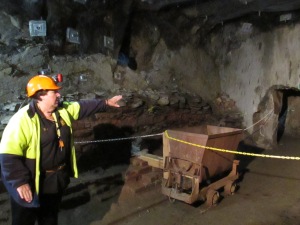
Our guide, Sue, had all kinds of stories about people getting killed in the mines and how long it took to dig the mine. Here she was explaining that they had cleared all the trees within 30km of the town to provide fuel for the boilers.

A neat cross section map of the mine. If you worked at a level about halfway down, it might take you over an hour to reach your post.
Some interesting factoids from the mining tour:
Ned Stringer, a former convict, was the first to register a gold claim in the area, but he died from tuberculosis before he could return to Stringer’s Creek to profit from his find. However, his find generated over 50 years of intense mining activity.
A boy could start work in the mines at age 16. If he made it to the ripe old age of 24 without being killed, he was considered lucky. If he made it to age 30, they pulled him out to do topside work.
If a miner was killed on the job, the other miners would pool their days wages (£3.10 a day, which was a lot of money back then, especially compared to the national average wage of 50 schillings a day) and give the money to the widow. The widow could use the money for a funeral (there are a lot of very big headstones in the town cemetery- probably not cheap!) or use it to leave town and set up a new life somewhere else. She might stay if she had a son old enough to send into the mines or if she could remarry.
The quartz reef in the mine yielded over 42 tons of gold by 1900. The entire Walhalla goldfield produced 70 tons of gold
The gold found in Walhalla largely funded the building of Collins Street in Melbourne.
The last death in the mines was in 1986 when a company wanted to try to reopen the mine. A man was killed when a section of rock collapsed on him and it took 6 months and $3 million to recover his body. After that, plans to reopen the mine were abandoned.
After the mine tour, we explored the town a bit. One of the coffee shops was open and we had a snack there and I got some postcards in the post office.
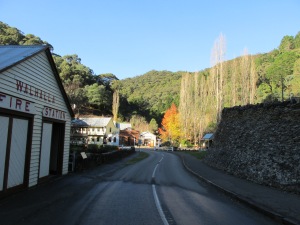
The Walhalla Fire Station is actually built over the creek, due to lack of flat ground in the area. The original station burned down in a bush fire, ironically.
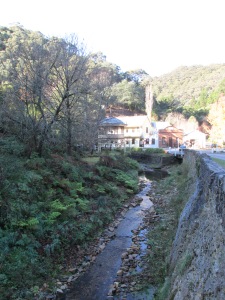
Stringer’s Creek. Supposedly contaminated with arsenic. I did notice that there were signs warning that the tap water was not suitable for drinking.

Not sure what kind of parrot this is, but there was a lot of very colourful, noisy bird life around.

This is the former bank vault. The rest of the bank was moved to Moe and the vault was left behind. Naturally, the bank closed when the mines closed.
I also wanted to see the cemetery. I don’t know why, but I always like seeing old cemeteries. They do run a ghost tour of the town on weekends, but as we weren’t staying the night, we figured we’d just go visit the ghosts ourselves before leaving.
The cemetery is set on a very steep hillside and doesn’t seem to be very well maintained. The footing is pretty treacherous and we both tripped and slipped a few times.
Many of the headstones are made of wood and the names have worn away long ago. Others are crumbling stone. But a few seem to be cared for on a regular basis and some old graves have had the headstones replaced with new ones in recent years. I always wonder about the forgotten, neglected graves- who those people were, what happened to their families. I suppose it’s not very nice to be lying cold and forgotten in the ground where no one remembers that you ever existed and I always spend a bit of extra time at the forgotten graves, in case no one else does.
Most of the graves are from the mid 1800s to the early 1900s. The rest are from the 1980s, probably from when people were drawn back to the town by the prospect of the mines reopening. Some graves contain entire families, including several where none of the children lived to see adulthood and many with teenaged boys who likely died in the mines. It’s quite sad to think of all the families that lost their sons, husbands, and fathers to the mines, all so that other people could get rich.
I have always found cemeteries to be hauntingly beautiful and the cool, autumn day, with the sun already dipping below the tree line, made the cemetery a very peaceful place to be. I suppose if you have to die and be buried, there are much worse places to seek eternal rest than in a quiet, abandoned mountain town.

The path up to the cemetery is lined with all the prehistoric looking plants that are so common in Australia. I love them and half expect to see a dinosaur crossing the path in front of us.
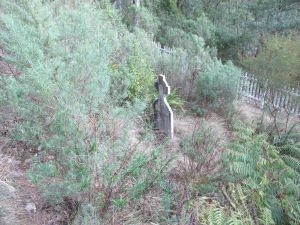
This lonely grave was tucked away into a far corner of the cemetery and was completely inaccessible, due to all the overgrown flora.
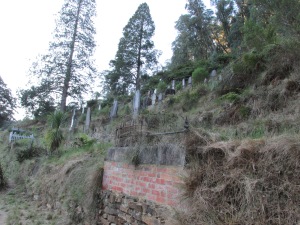
As you can see, the ground is very steep. There are lots of roots and prickly things just waiting to snare an unwary visitor.
We left Walhalla after our visit to the cemetery, as everything was closing up and we still had to make our way to Bairnsdale for the night. On the drive down the mountain, we saw numerous lyrebirds running around, which I have never seen before in the wild. If you’ve never seen one and want to, this is apparently the area to go to!
I definitely recommend Walhalla for anyone interested in gold mining history or anyone who just wants to get away from the city and go somewhere peaceful for a while (like us). There is a lot more to do during peak season and on the weekends, but going on a Friday and being some of the few people there was really nice and relaxing. It’s a place I’d love to go back to.
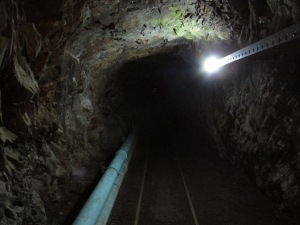
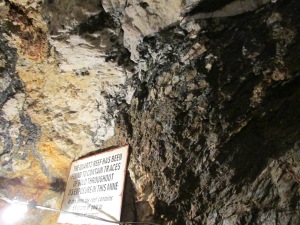

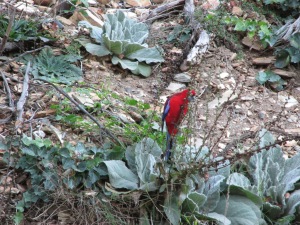







I love Walhalla too. Even though you’ve seen a lot of the “sights”, you should stay overnight next time. The Star Hotel is wonderful, and there’s a little steam train trip you can do as well. The hotel has a great history, and its re-opening was the catalyst for the town getting electricity – I think that was only about 10 years or so ago! Enjoyed reading your view of it!
We definitely want to go back and stay overnight. The only reason we didn’t is because we were also doing the Great Alpine Road that weekend and needed to make some headway.
I so enjoyed reading this post and looking at your photos. I’ve only been to Walhalla once and that was many years ago, so this really brought back memories. The green and red parrot you didn’t recognise is a “King Parrot”. We get them in our yard now and then – they are one of the most beautiful of our parrots, even though they are only two colours!
They are gorgeous birds! Thanks for letting me know what kind it is. I often see beautiful birds here and don’t know what they are called.